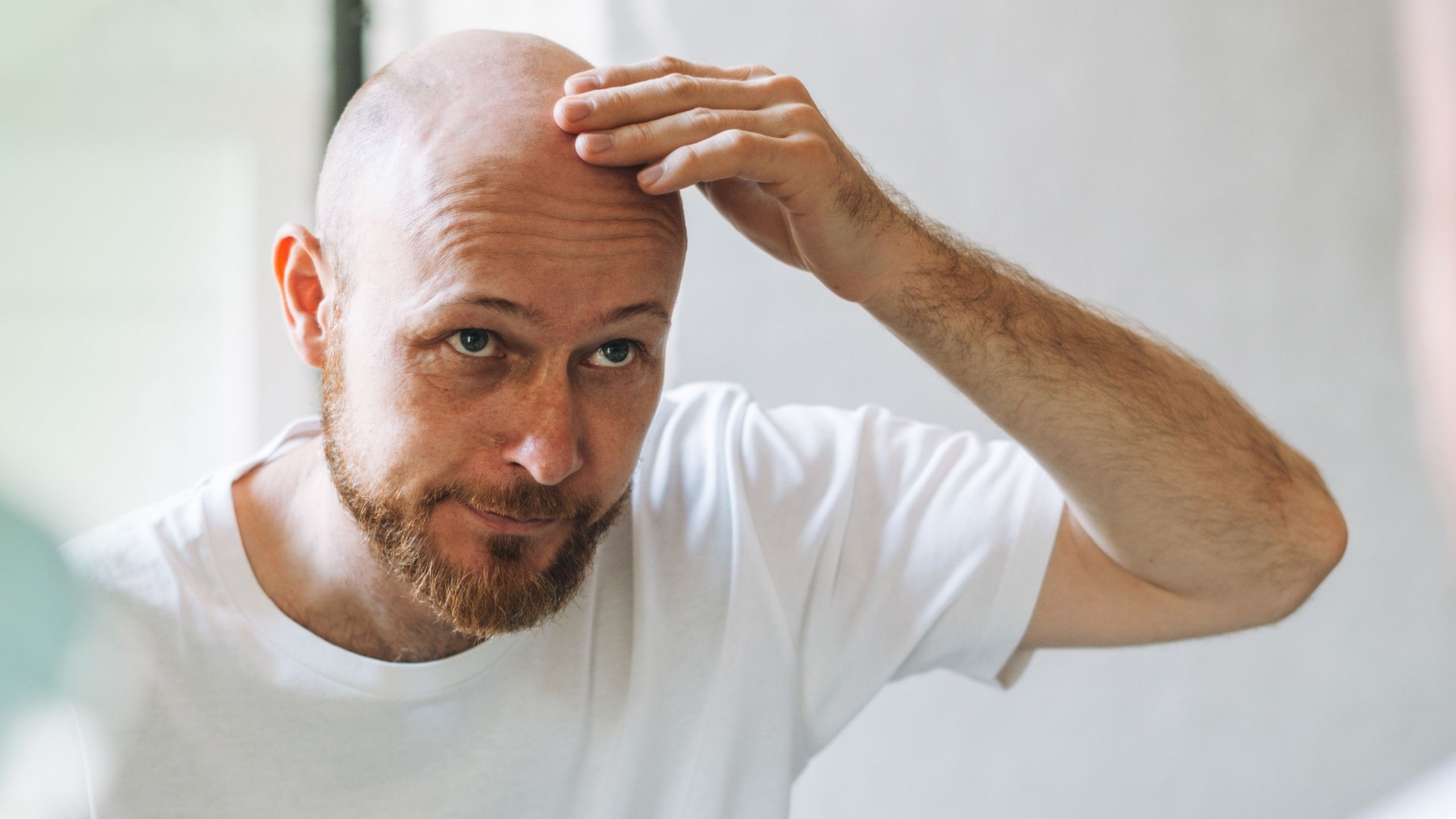Male Pattern Baldness: What is the Cause of Male Pattern Baldness?
Male pattern baldness, clinically known as androgenic alopecia, is a common condition affecting men worldwide. Characterized by a gradual thinning of hair, especially at the crown and temples, this condition can significantly impact a man’s self-esteem and physical appearance. Understanding the causes, signs, and available treatments for male pattern baldness is crucial for those experiencing this condition. This article will explore various aspects of male pattern baldness, helping readers gain a comprehensive understanding of this prevalent issue.
What is Male Pattern Baldness?
Male pattern baldness is a hereditary condition that leads to progressive hair loss in men. It typically follows a recognizable pattern, starting with a receding hairline and thinning at the crown. The condition can vary in severity, with some men experiencing only minimal hair loss, while others may become completely bald.
Male pattern baldness is often associated with hormonal changes, particularly the effects of androgens, which are male hormones that can shrink hair follicles and shorten the hair growth cycle. While commonly referred to as male pattern baldness, it’s important to note that women can also experience a similar condition, known as female pattern baldness, although the patterns of hair loss differ. Understanding male pattern baldness is essential for recognizing its symptoms and seeking appropriate treatments.
Advice: Afro Hair Transplant Turkey

Who Is Affected by Male Pattern Baldness?
Male pattern baldness affects a significant portion of the male population, with estimates suggesting that about 50% of men will experience some degree of hair loss by the age of 50. The onset of male pattern baldness can begin as early as the late teens or early twenties, but it is more common in older men. Factors such as genetics play a crucial role in determining who is affected.
If a man has a family history of baldness, he is more likely to experience similar hair loss. Additionally, hormonal changes and health conditions can influence the onset and progression of male pattern hair loss. While it primarily affects men, it is worth noting that female pattern baldness can occur, particularly during menopause or due to hormonal imbalances. Understanding who is affected by male pattern baldness can help in identifying risk factors and seeking early intervention.
How Does Male Pattern Baldness Influence Your Physical Appearance?
The influence of male pattern baldness on physical appearance can be profound. As hair thins and recedes, a man’s overall look can change significantly, often leading to feelings of self-consciousness. Many men associate a full head of hair with youth and vitality, so hair loss can impact their confidence and how they perceive themselves. The visible signs of baldness, such as a receding hairline or thinning crown, can alter facial proportions, making some individuals appear older than their actual age.
Additionally, societal perceptions often associate baldness with aging or declining attractiveness, which can further affect self-esteem. While some men embrace their baldness, opting for a shaved look, others may feel compelled to seek treatment to restore their hair. Understanding how male pattern baldness influences physical appearance is essential for addressing the emotional and psychological aspects associated with this condition.
Advice: FUE Hair Transplant Turkey
What Are the Common Signs of Male Pattern Hair Loss?
Recognizing the common signs of male pattern hair loss is crucial for early intervention and effective treatment. Identifying these indicators early can significantly impact the management of hair loss and help individuals take proactive steps. Here are the key signs to watch for:
- Receding Hairline:
One of the first signs of male pattern hair loss is a receding hairline. This typically begins at the temples and can gradually form an “M” shape. The hairline may become less pronounced, and as it retreats, it can create a noticeable difference in appearance. Many men first notice this change in their late teens or early twenties. - Thinning Crown:
Another common sign is noticeable thinning at the crown or vertex of the scalp. This area may start to lose hair density, leading to bald spots that become increasingly apparent over time. The thinning crown can contribute to an overall perception of hair loss, often prompting men to seek treatment. - Increased Hair Loss:
An increase in hair shedding is a significant indicator of male pattern baldness. Men may notice more hair in the shower drain, on their pillows, or in their hairbrushes. If the amount of hair lost during daily grooming routines seems excessive, it could signal the onset of hair loss. - Changes in Hair Density:
As male pattern baldness progresses, overall hair density decreases. This can make the scalp more visible, especially when the hair is wet or styled. Thinning hair can lead to a noticeable change in how the hair lies, often making it appear flat or limp. - Bald Spots:
Over time, the areas of thinning may grow larger, leading to distinct bald spots. These spots can spread, resulting in significant baldness at the crown or along the hairline. In advanced stages, men may experience complete baldness in certain areas, which can be distressing.
Monitoring these signs closely can help men address hair loss proactively. By recognizing the early indicators of male pattern baldness, individuals can seek appropriate treatments sooner, whether through medical interventions, lifestyle changes, or hair restoration options. Early action can often lead to better outcomes, allowing for more effective management of hair loss and improved confidence in one’s appearance.
What Are the Main Causes of Male Pattern Baldness?
Male pattern baldness, also known as androgenic alopecia, is influenced by several key factors. Understanding these causes can empower individuals to seek appropriate treatment options and take proactive measures. The primary causes include:
- Genetic Predisposition:
Genetics play a crucial role in male pattern baldness. If there is a family history of baldness, particularly on the maternal side, the likelihood of developing this condition increases significantly. Specific genes associated with hair loss can be inherited, making some individuals more susceptible. - Hormonal Factors:
Androgens, specifically dihydrotestosterone (DHT), are pivotal in the hair loss process. DHT is a derivative of testosterone that can bind to hair follicle receptors, leading to follicle shrinkage and a shortened hair growth cycle. Over time, this results in thinner hair and eventual hair loss. - Age:
The risk of male pattern baldness rises with age. As men get older, their hair follicles may become increasingly sensitive to DHT, leading to more pronounced hair loss. Studies suggest that by age 50, approximately 50% of men will experience some degree of baldness, highlighting the impact of aging on hair health. - Health Conditions:
Various medical conditions can contribute to hair loss. Thyroid disorders, for instance, can disrupt the balance of hormones essential for hair growth. Additionally, scalp infections or conditions like alopecia areata can result in hair loss, complicating the picture of male pattern baldness. - Stress:
Psychological and physical stress can exacerbate hair loss in some individuals. Stress triggers a physiological response that can push hair follicles into a resting phase, leading to increased shedding. Chronic stress may also influence hormonal levels, further impacting hair health. - Poor Nutrition:
A balanced diet is vital for maintaining healthy hair. Deficiencies in essential nutrients, such as vitamins (like A, D, and E), minerals (like zinc and iron), and proteins, can weaken hair strands and lead to thinning. Ensuring adequate nutrition can support hair health and mitigate some effects of male pattern baldness.
Understanding these causes can help men identify effective treatments and take proactive steps toward managing their hair loss. By addressing these factors—whether through lifestyle changes, medical interventions, or dietary adjustments—individuals can enhance their chances of maintaining a fuller head of hair.
How Is Male Pattern Baldness Diagnosed?
Diagnosing male pattern baldness typically involves a thorough evaluation by a healthcare professional or dermatologist. The diagnosis often begins with a detailed medical history and a physical examination of the scalp. During this assessment, the doctor looks for characteristic patterns of hair loss, such as a receding hairline or thinning at the crown, which are indicative of male pattern baldness. In some cases, additional tests may be conducted to rule out other causes of hair loss, such as hormonal imbalances or underlying health conditions. Blood tests can help identify issues that might contribute to hair loss, such as thyroid dysfunction. Understanding the diagnosis process for male pattern baldness is important for individuals seeking clarity about their hair loss and potential treatment options.

What Are the Treatment Options for Male Pattern Baldness?
Treatment options for male pattern baldness vary depending on the severity of hair loss and individual preferences. One of the most common treatments is minoxidil for men, a topical solution that promotes hair regrowth and slows down hair loss. Minoxidil works by increasing blood flow to hair follicles and prolonging the hair growth phase. Another popular option is finasteride, an oral medication that reduces DHT levels, thereby preventing further hair loss.
For men seeking more immediate results, hair transplant procedures, such as FUE (Follicular Unit Extraction) or FUT (Follicular Unit Transplantation), can provide a permanent solution by relocating hair follicles from donor areas to balding regions. Additionally, low-level laser therapy devices are gaining popularity for their non-invasive approach to stimulating hair growth. Understanding the various male pattern baldness treatment options is essential for individuals looking to address their hair loss effectively. Consulting with a healthcare provider can help determine the best course of action based on individual needs and circumstances.

















